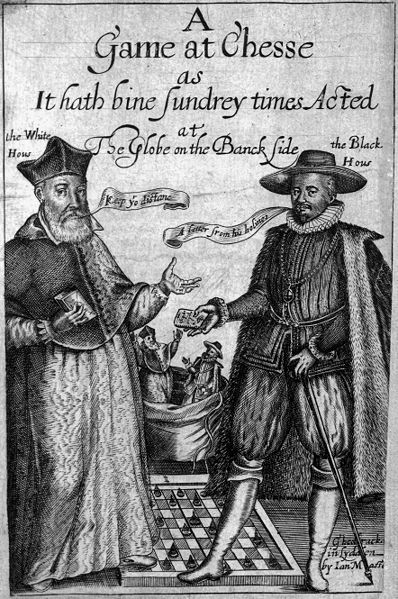A Game at Chess (drama): Difference between revisions
No edit summary |
No edit summary |
||
| (2 intermediate revisions by the same user not shown) | |||
| Line 41: | Line 41: | ||
[[Category:Thomas Middleton (1580 - 1627): English dramatist]] | [[Category:Thomas Middleton (1580 - 1627): English dramatist]] | ||
{{DISPLAYTITLE:<span style="font-style: italic;">A Game at Chess</span> (drama)}} | |||
__NOTOC__ | __NOTOC__ | ||
Latest revision as of 20:51, 1 December 2011
Date: 1624
Region: Europe
Subject: Political/Economic/Social Opinion
Medium: Theatre Literature
Artist: Thomas Middleton (1580 - 1627): English dramatist
Confronting Bodies: The Spanish Government and the Spanish Royal Family; the British Royal Family
Dates of Action: 1624
Location: London, England
Description of Artwork: Thomas Middleton's play, A Game at Chess is a thinly disguised allegory of the failed marriage alliance between the thrones of England/Scotland and Spain in 1623. The play examined the real-life drama surrounding the impending marriage of the heir to the thrownes, prince Charles, and the Spanish princess Donna Maria. James I wanted a Spanish match for his son, as it would result in an important alliance and trade advantages with the New World. In exchange, the Spanish insisted upon the suspension of penal laws against Catholics in England. Ultimately, the marriage fell through after Spain refused to promise extensive military aid to England. In A Game at Chess, the "Black House" (Spain) seeks to corrupt members of the "White House" through the use of romantic relationships. In the play, members of the "Black House" are portrayed in unflattering ways while characters in the "White House" are presented in a sympathetic manner. In the end, the "White House" exposes the corruption of the "Black House".
The Incident: During the 1600s, tradition held that it was forbidden to portray living monarchs on stage in an unfavorable manner. However, the British government granted Middleton permission to perform his play. In August of 1624, the play premiered in London and was an immediate success. However, the Spanish ambassador angerly informed King James I that the play presented an unfair anti-Spanish feeling to such a degree that he no longer felt safe living in London. The ambassador demanded that the actors be punished, or else the king should be prepared for severances of all relations between Spain and England.
Results of Incident: Due to Spain's threats, King James called for the actors and Middleton to appear before him to discuss the matter. The actors appeared and were told that they were forbidden to perform. Failing to appear, a warrant was put out for Middleton's arrest. When he could not be found, his 20-year-old son, Edward, was brought in for questioning but was unwilling to provide information about his father. When Middleton finally did resurface, he spent some time in Fleet Prison awaiting formal pardon by the king. The length and circumstances of his imprisonment are unknown, but it is thought that he was released. No further performances of the play were allowed.
Source: Censorship: A World Encyclopedia. Ed. Derek Jones. Chicago; London: Fitzroy Dearborn, 2001.
